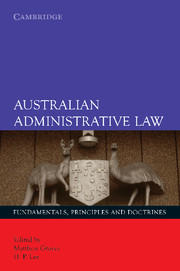Book contents
- Frontmatter
- Contents
- Foreword
- Preface
- About the contributors
- Table of cases
- Table of statutes
- 1 Australian administrative law: The constitutional and legal matrix
- 2 Administrative law in Australia: Themes and values
- 3 The public/private distinction in Australian administrative law
- 4 Australian administrative law: The human rights dimension
- 5 Administrative tribunals
- 6 Australian Ombudsman: A continual work in progress
- 7 Freedom of information
- 8 Delegated legislation
- 9 The concept of ‘justiciability’ in administrative law
- 10 Standing
- 11 Reasons for administrative decisions: Legal framework and reform
- 12 Relevant and irrelevant considerations
- 13 Improper purpose
- 14 Reasonableness, rationality and proportionality
- 15 The ‘no evidence’ rule
- 16 Failure to exercise discretion or perform duties
- 17 Procedural fairness: The hearing rule
- 18 The doctrine of substantive unfairness and the review of substantive legitimate expectations
- 19 The impact and significance of Teoh and Lam
- 20 The rule against bias
- 21 Jurisdictional error without the tears
- 22 Privative clauses and the limits of the law
- 23 Administrative law judicial remedies
- Endnotes
- Index
22 - Privative clauses and the limits of the law
Published online by Cambridge University Press: 05 June 2012
- Frontmatter
- Contents
- Foreword
- Preface
- About the contributors
- Table of cases
- Table of statutes
- 1 Australian administrative law: The constitutional and legal matrix
- 2 Administrative law in Australia: Themes and values
- 3 The public/private distinction in Australian administrative law
- 4 Australian administrative law: The human rights dimension
- 5 Administrative tribunals
- 6 Australian Ombudsman: A continual work in progress
- 7 Freedom of information
- 8 Delegated legislation
- 9 The concept of ‘justiciability’ in administrative law
- 10 Standing
- 11 Reasons for administrative decisions: Legal framework and reform
- 12 Relevant and irrelevant considerations
- 13 Improper purpose
- 14 Reasonableness, rationality and proportionality
- 15 The ‘no evidence’ rule
- 16 Failure to exercise discretion or perform duties
- 17 Procedural fairness: The hearing rule
- 18 The doctrine of substantive unfairness and the review of substantive legitimate expectations
- 19 The impact and significance of Teoh and Lam
- 20 The rule against bias
- 21 Jurisdictional error without the tears
- 22 Privative clauses and the limits of the law
- 23 Administrative law judicial remedies
- Endnotes
- Index
Summary
Judicial review and privative clauses
The idea that courts or other legal bodies should play a role in overseeing administrative action is central to modern notions of democratic governance. However, it seems to be in the common law countries – United Kingdom, United States, Canada and the nations of the British Commonwealth – that the most complex oversight regimes have been created. This may be because of the sometimes nebulous distinction drawn in those countries between administrative review (review of the merits of administrative action) and judicial review (review of the legality of such action). The distinction is manifest on the one hand in the creation of both specialist and multi-jurisdictional tribunals or agencies charged with the review and/or re-making of administrative decisions. On the other hand are courts of law vested with constitutional or statutory authority to check that administrative decisions (including decisions made by those tribunals or agencies) have been made in accordance with the law.
It is a system built on a sequencing of functions between administrators, tribunals and courts, which are arranged in a natural hierarchy. This can militate against ‘efficiency’ in both administration and governance, in that a system involving decision-making by representatives of two branches of government creates a necessarily complex matrix of avenues for review. Thus in a sense, the Anglo-Australian system of judicial review is less efficient than, say, the French droit administratif.
- Type
- Chapter
- Information
- Australian Administrative LawFundamentals, Principles and Doctrines, pp. 345 - 367Publisher: Cambridge University PressPrint publication year: 2007
- 1
- Cited by

